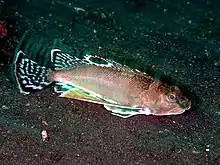Apistinae
Apistinae, the wasp scorpionfishes, is a subfamily of venomous, marine ray-finned fishes belonging to the family Scorpaenidae, the scorpionfishes and related species. These fishes are native to the Indian Ocean and the western Pacific Ocean.
| Apistinae | |
|---|---|
 | |
| Ocellated waspfish (Apistus carinatus) | |
| Scientific classification | |
| Domain: | Eukaryota |
| Kingdom: | Animalia |
| Phylum: | Chordata |
| Class: | Actinopterygii |
| Order: | Scorpaeniformes |
| Family: | Scorpaenidae |
| Subfamily: | Apistinae T. N. Gill, 1859[1] |
| Genera | |
|
see text | |
Taxonomy
Apistinae, or Apsitidae, was first formally recognised as a taxonomic grouping in 1859 by the American ichthyologist Theodore Gill.[1] The 5th edition of Fishes of the World treats this as a subfamily of the scorpionfish family Scorpaenidae,[2] although other authorities treat it as a valid family, the Apistidae.[3] The name of the subfamily is based on the genus name Apistus, which means "untrustworthy" or "perfidious", a name Cuvier explained as being due to the long and mobile spines around the eyes, which he described as “very offensive weapons that these fish use when you least expect it”.[4]
A recent study placed the wasp scorpionfishes into an expanded stonefish clade (Synanceiidae) because all of these fish have a lachrymal saber that can project a switch-blade-like mechanism out from underneath their eye.[5][6]
Genera
Characteristics
Apistinae species have either 1 or 3 lower pectoral fin rays which are free of the fin membrane and a swimbladder with 2 lobes.[2] They are fairly small fishes reaching lengths of 15 centimetres (5.9 in) TL in the humpback waspfish[8] to 20 centimetres (7.9 in) TL in the ocellated waspfish.[3]
Distribution and habitat
Apistinae species are found in the Indian and Pacific Oceans from the Red Sea and the eastern coast of Africa east in to the western Pacific Ocean, north to Japan and south to Australia. They are demersal species of the continental shelf and may be found over soft substrates or on reefs.[3]
References
- Richard van der Laan; William N. Eschmeyer & Ronald Fricke (2014). "Family-group names of Recent fishes". Zootaxa. 3882 (2): 001–230. doi:10.11646/zootaxa.3882.1.1. PMID 25543675.
- J. S. Nelson; T. C. Grande; M. V. H. Wilson (2016). Fishes of the World (5th ed.). Wiley. pp. 468–475. ISBN 978-1-118-34233-6. Archived from the original on 2019-04-08. Retrieved 2022-03-13.
- Froese, Rainer, and Daniel Pauly, eds. (2022). "Apistidae" in FishBase. February 2022 version.
- Christopher Scharpf & Kenneth J. Lazara, eds. (10 March 2022). "Order Perciformes (Part 10): Suborder Scorpaenoidei: Families Apistidae, Tetrarogidae, Synanceiidae, Aploacrinidae, Perryenidae, Eschmeyeridae, Pataceidae, Gnathanacanthidae, Congiopodidae and Zanclorhynchidae". The ETYFish Project Fish Name Etymology Database. Christopher Scharpf and Kenneth J. Lazara. Retrieved 13 March 2022.
- Smith, W. Leo; Smith, Elizabeth; Richardson, Clara (February 2018). "Phylogeny and Taxonomy of Flatheads, Scorpionfishes, Sea Robins, and Stonefishes (Percomorpha: Scorpaeniformes) and the Evolution of the Lachrymal Saber". Copeia. 106 (1): 94–119. doi:10.1643/CG-17-669. S2CID 91157582.
- Willingham, AJ (April 13, 2018). "Stonefish are already scary, and now scientists have found they have switchblades in their heads". CNN.
- Eschmeyer, William N.; Fricke, Ron & van der Laan, Richard (eds.). "Genera in the family Scorpaenidae". Catalog of Fishes. California Academy of Sciences. Retrieved 13 March 2022.
- Mees G.F. (1964). "A new fish of the family Scorpaenidae from New Guinea". Zoologische Mededelingen. 40 (1): 1–4.